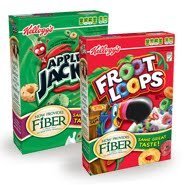This week, Washington, DC-based Center for Science in the Public Interest released a report analyzing the nutritional quality of foods marketed to children on Nickelodeon. The report is a follow-up to CSPI’s 2005 report and Guidelines for Responsible Food Marketing to Children. The report found that 80% of Nickelodeon food commercials are for poor nutritional-quality foods, down from 90% of all food commercials included in the 2005 study.
One of the most troubling areas highlighted in the study was the dismal performance of children’s cereals advertised on Nickelodeon. Ten percent of all of the food advertisements on Nickelodeon during the CSPI study period were for cereal. Of these, almost 60% were cereals of poor nutritional quality:
CSPI recommends that to be of high-nutritional value, a cereal should have at least 2.5 g of fiber or 8 g whole grain and should contain 10% daily value for fiber as well as vitamins A, C, E, calcium, magnesium, potassium, iron and protein. Ready to eat cereals can (and should!) be a great source of iron-fortified, whole-grain carbohydrate for kids. The reality is – the ones marketed directly to children rarely are.
The CSPI report comes on the heels of a recent backlash against high sugar cereals like Apple Jacks and Froot Loops masquerading as “good sources” of fiber. The FDA allows the claim “good source of fiber” for foods that have 2.5 to 4.9 grams of fiber per serving; the FDA does not allow the “good source” claim if that same food has one of the following per serving:
- More than 13 grams of fat
- More than 4 grams of saturated fat
- More than 60 milligrams of cholesterol
- More than 480 milligrams of sodium
Another recent report on the marketing and deleterious effects of high-sugar cereals comes from Kelly Brownell, Ph.D. of Yale University’s Rudd Center for Food Policy and Obesity. This October 2009 study reported that cereals marketed directly to kids have 85% more sugar, 65% less fiber and 60% more sodium than adult cereal. And not only do marketers target high-sugar cereals to kids, but they adorn those same cereal boxes with “better-for-you” industry-created, controversial front-of-package labeling.
In the United States there are no laws that prohibit direct marketing of unhealthy foods to children, despite the obviously negative effects that have been borne out in recent studies. Rather, any limitations are industry-opposed, and largely ignored. The Institute of Medicine of the National Academies stated in 2006, “Industry should develop and strictly adhere to marketing and advertising guidelines that minimize the risk of obesity in children and youth”. But since nobody is making industry do anything to limit marketing that makes kids fat, what can be done?
Health and nutrition think tanks and research institutions continue to rely on industry self-regulation and pressure tactics as their only tool in this uphill battle. CSPI’s Key Recommendations from this week’s report include:
- Chuck E. Cheese’s, Perfetti van Melle (maker of Air Heads candy), IHOP restaurants, Topps Candy (maker of Baby Bottle Pop candy), YUM! Brands (KFC, Taco Bell, Pizza Hut), and all other food and beverage companies that market to children – through television or any other media – should join the Children’s Food and Beverage Advertising Initiative (CFBAI)
- The Council of Better Business Bureaus should revise its CFBAI guidelines to include a set of nutrition standards, which all participating companies must comply with, such as those being
developed by the Interagency Working Group on Food Marketed to Children - Nickelodeon and other media companies should have comprehensive policies for marketing to
children that cover all their media and should air only ads aimed at children for foods that meet
strong nutrition standards
What if you or your kids – God forbid – still want to eat cereal?! The Brownell/Yale report created a Nutrition Profile Index (NPI) score ranking all child and family cereal brands stocked in more than 5% of supermarkets in May 2009. According to their report, the top 15 most nutritious cereals are (in decreasing order of nutritional quailty):
- Kellogg Mini-Wheats
- Barbara’s Bakery Organic Wild Puffs
- Kashi Mighty Bites
- Kashi Honey Sunshine
- Cascadian Farm Clifford Crunch
- Kellogg Hannah Montana
- General Mills Kix
- Quaker Life
- General Mills Cheerios (excluding Honey Nut)
- Barbara’s Bakery Puffins
- Annie’s Bunnies
- Nature’s Path EnviroKidz Organic
- General Mills Dora the Explorer
- Cascadian Farm Cinnamon Crunch
- Post Raisin Bran
A final set of recommendations for choosing a healthy cereal comes from sports dietitian Nancy Clark and her Sports Nutrition Guidebook (3rd ed.):

